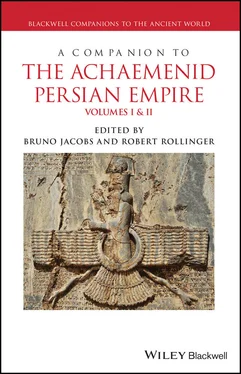King Cyrus (II) of Parsu mustered his army and crossed the Tigris downstream from Arbēla (Erbil) and, in the month of Iyyar, [march]ed to X [???]. / He defeated its king (or: put its king to death), seized its possessions, [and] set up his own garrison [there]. After that, the king and his garrison resided there
(Nabonidus Chroncile ii 15–18; Grayson 2000: p. 107).
The document's geographical perspective reveals an important dimension of argumentation, although this crucial point is generally nearly totally ignored, for the alleged statement that Cyrus crossed the Tigris and marched toward Lydia is very difficult to explain. According to Google Maps, the distance between Erbil and Sardis is 1739 km, calculating the shortest route through upper Mesopotamia crossing the Euphrates at Birecik and continuing via Gaziantep to the west. But, Cyrus could not have taken this short route, for most of the area was, at least at that time, controlled by the Babylonians (Jursa 2003; Rollinger 2003a). If the reading Lu‐[???] is supposed to be correct, he must have taken a route via eastern Anatolia that was about 2000 km in length. This is slightly less than the distance between Cologne and Moscow (about 2300 km). From this perspective, such an interpretation becomes hardly tenable. It is as if a nineteenth‐century central European chronicle on Napoleon's campaign against the Tsar had described the event as follows: “The French emperor crossed the river Rhine below Cologne and marched against Moscow.” 2 Lydia is therefore not really an option, whereas the reading Ú‐[???] is still a very attractive one. But even if this reading cannot be proven definitively, it is clear that Cyrus marched against a still independent country in the immediate reach of a route along the Tigris, and a region in eastern Anatolia is a very good candidate. Thus the chronicle becomes an important testimony also for Median history, for it proves that Cyrus' conquest of Ekbatana did not mean that he was also in control of eastern Anatolia. Apparently, there still existed an important political entity in this area that was only conquered by Cyrus in 547 BCE. There is further indirect evidence for this.
We know that Darius I and Xerxes set up inscriptions not only in their favorite residences, like Persepolis and Susa, but also in residences of those former political entities that were conquered by Cyrus and in which the early Achaemenids presented themselves as true and legitimate successors of their Teispid predecessors (Rollinger 2015: pp. 118–120). This is true for Hamadan and Babylon, for example, but also for Van. The inscription placed at a steep rocky flank of the former Urartian capital was obviously tremendously important, for Xerxes explicitly mentions that his father Darius already intended its construction, but only he was able to achieve this. The inscription only makes sense, however, if the choice of the location commemorates the former capital of a substantial political entity that ended through Teispid conquest. Together with the evidence from the Nabonidus Chronicle, this means that in the first half of the sixth century BCE the Medes cannot have been in permanent control of eastern Anatolia. Their power was mainly limited to the central Zagros area.
This now brings the Classical sources into play, for there is, for example, Herodotus' testimony that during an eclipse generally dated to 585 BCE, the Medes and the Lydians met at the river Halys in central Anatolia to forge an alliance. Although many historians still treat Herodotus as sourcebook, simply used like a quarry to rephrase history, it is increasingly clear that he has to be dealt with as a literary work completed during the Peloponnesian War, presenting a view on the past, first and foremost, through a Greek lens of around 420 BCE. In his Histories he skillfully elaborates ancient Near Eastern history as a sequence of empires, where empire is modeled according to the Persian‐Achaemenid empire of Herodotus' own time (Bichler 2000; Rollinger 2003c, 2014; Rollinger et al. 2011). This is also the guiding principle of Ctesias' work, which survived only in fragments, developing Herodotus' concept of a Median “empire” even further (Wiesehöfer et al. 2011; Waters 2017). It is Herodotus, and especially Ctesias, who formed the basis for later Classical sources that structured world history as a sequence of empires – a view that was adopted by late antique Christianity and passed on through the Middle Ages to modern times (Wiesehöfer 2003, 2005). It is mainly this reception history that saved for the Medes a prominent place in a Western view of world history canonized over a lengthy period. Both Herodotus and Ctesias describe Median history as a succession of kings ruling a united and far‐reaching territory from the beginning to the very end (Rollinger 2010, 2011, 2020a). Apart from the name of the last king, Astyages, however, they completely disagree about the number of these kings, their names, and the duration of the Median period. With indigenous ancient Near Eastern sources they share only two facts: it was the Medes who brought the Assyrian Empire to an end, and it was Cyrus who overcame Astyages. It was apparently the fall of the Assyrian Empire that directed historical attention toward the Medes, yet without much further information on what these Medes really were. Herodotus, moreover, reports a famous story about how the Medes established monarchy. But this story has been decoded as a mix of Iranian mythology and sophistic Greek theories of the end of the fifth century BCE on how states come into being (Panaino 2003; Meier et al. 2004; see also Gufler 2016, and Degen/Rollinger 2020). Whereas Ctesias' Medes control the entire Ancient Near East, those of Herodotus do not. Their reach extends as far west as the river Halys (Kızılırmak) where they allegedly share a border with the Lydians. This border looks very much like a Greek construction of the fifth century BCE to organize ancient Near Eastern history, however (Rollinger 2003a). And to prove such a construction it is connected with a legendary story. This is exactly the “historical” context for localizing the Median‐Lydian treaty at the Halys river and for the famous story about the sage Thales, who predicted an eclipse of the sun that brought Median‐Lydian strife to an end. The Medes might have been roaming through Anatolia for a very brief period of time, and they may indeed have concluded a treaty with the Lydians, but there was no permanent Median control of eastern – let alone central – Anatolia in the sixth century BCE. 3
Finally, some additional evidence demonstrates that the claim for a Median “empire” lacks a solid basis. 4 There are no archeological remains of imperial centers, nor are there documentary archives surviving from a supposed Median administration. Not a single document has come down to us from their supposed domain, since multiple documents previously thought to have done so have been shown to be untrustworthy. There is also no contemporary correspondence between foreign kings and Median rulers, neither from Babylonia nor from any other country. In the entire 3000‐year history of the Ancient Near East, the Medes would thus have established the only “empire” from which no kind of textual documentation, neither from inside nor from outside, has survived to this day.
In addition to these negative findings, which result from careful reevaluation of existing evidence, the model of a geographically and chronologically limited political “confederation” dominated by Iranian peoples has been developed as an alternative to the notion of a Median “empire.” In the short term, this confederation likely played an important role in the immediate aftermath of the fall of the Neo‐Assyrian Empire, though it was never to develop comparable imperial structures. Indeed, a prime motivation of the members of this “confederation” is said to have been raids reaching as far as central Anatolia. There was no organized “rule” as such, no stable authority, as the “confederation” was in itself a short‐lived collective brought together by momentarily overlapping goals and ambitions. As such, it was more likely dominated by short‐term alliances and dependencies which would scarcely have endured beyond the next raiding season. If any coherent order of rule developed at all, as this theory goes, it could only have happened in the central Zagros region between Lake Urmia and Elam. The loose, mixed structure of the short‐termed Median confederation is also confirmed by the wording of the Nabonidus inscriptions, which carry clear connotations of disorder and chaos when dealing with the Medes. The Medes' appearance is characterized as a great flood and their military organization is described as a loose confederacy with primitive hierarchies. Significantly, this confederation revolving around a charismatic leader is circumscribed by the formulation of “Kings who march at his side” (Rollinger 2003a: p. 318). Moreover, particular verses in the Book of Jeremiah paint a similar picture by describing Median kings (plural!) as part of a larger federation (Liverani 2003).
Читать дальше












